I’ve seen estimates of spider density (the number of spiders in a given area) that range from 11,000 spiders per acre (in woodlands) to over 1 million (some estimates go as high as 2.5 million) per acre in a grassy field. Now that’s a lot of spiders!
Here at the homestead, I don’t think we have quite so many. Oour 1/4-acre lot has its share, but I suspect that the combined footprint of the swimming pool and the house skew the numbers downward. Nevertheless, they are quite visible lately. The autumn months (even in the “autumn-less” land of Florida), particularly October and November, are when spiders are at their most conspicuous, and I sure have been seeing a lot lately.
In fact, I have found over a half dozen different species that I haven’t told you about before; enough to start a miniseries on spiders.
If you don’t know yet, let me tell you now, spider identification is for neither the faint-hearted nor the lightly equipped naturalist. In order to identify all but the most conspicuous and common spiders correctly to the species level, you need a dissecting microscope or a very good macro lens and lots of luck. I make do with neither because, fortunately, for most people, including naturalists like me, identification to the family level is often “good enough.” (I’m thinking of starting a new blog, “the lazy naturalist,” but somehow I can never seem to find the time!)
If you can get a photo that shows the eye arrangement well enough, your task is greatly eased, because each spider family (or subfamily) has a fairly distinct arrangement. It’s not as foolproof as dissecting the genitalia, but it gets you as close as most people are willing to get…
Once you’ve managed to narrow down your spider’s ID to the family level, your location can narrow it down further, because there will usually be just a few species from which to choose in a given area, and odds are that your most common and conspicuous spiders will be fairly easy to identify (but, as this series of posts will show, it gets harder the closer you look).
So, to inaugurate this little spider series, I propose an unusual spider that I found, not at the homestead proper, but at the Children’s Museum a couple of blocks away. The museum is in a lovely historic home (built in 1912), white wood with green trim:
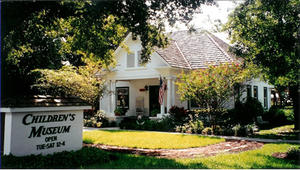
It’s kept up immaculately despite (and because of) the amount of kid traffic it receives. Inside, it has lots of toys, play scenarios, and what-do-you-call-em’s to keep kids busy, like this ride-on airplane:
But after hours and hours in the place, the attention of its adult visitors tends to wander. And when it wanders to the view through a few of the windows, that visitor might be able to see, not just what’s outside the window, but what’s “on” the window. A rather unusual-looking greenish-whitish transclucentish spider:
Her “knobby” abdomen might remind you of the spiny-backed orbweavers (the so-called crab spiders, as distinct from the true crab spiders). For example, Gasteracantha cancriformis has spikes on her abdomen as well:
But the abdomen of the spider pictured ends in sort of a “fishtail” arrangement that tells you right away that she’s no “crab” spider. Her taxonomic name is Allocyclosa bifurca, and not only does she have an unusual appearance but she also has an unusual web-building habit, and one that makes her web conspicuous to a distracted museum-goer: she makes a unique “stabilimentum” in her web by weaving her egg sacs in a vertical line above her body, and her discarded meals in a line below her, as described on Bugguide.net and illustrated below the quote:
This orbweaver does an interesting thing in its web, which is rightfully referred to as protective mimicry. The egg sacs are attached to the web in a straight up vertical row and act as a sort of stabilimenta. And the discarded prey carcasses are kept the same way, except in a row straight down. The females perch in the center of the web in between the egg sacs and the carcasses and are difficult to make out since the spider and the egg sacs are both green and also similarly shaped.
As you can see, this individual has probably had quite a few meals that don’t show up in her trashpile; I doubt that she was able to produce so many egg sacs from that one bit of discarded prey hanging beneath her… Here’s a better picture of her web:
I say “her” because the males of this species are so rare that one arachnologist has even wondered aloud (and in print) whether the species is parthenogenic!
This spider is typically found exactly where I found it at the museum: under the eaves of houses. The very first description of it, all the way back in 1887, was made from a spider found on the porch of a house on Merritt Island. (It also seems to be a Florida, or at least a southern, spider: the only two states with data points for it on bugguide.net are Florida and Texas.) I haven’t found it on my homestead yet, but I will keep looking!
The taxonomic name is fairly interesting: Allocyclosa means “like” or “similar to” Cyclosa, and in fact, this species used to be placed in that genus. The name Cyclosa means “to move in a circle, circling spider,” which could fairly be applied to almost all orbweavers but, owing to the rules of taxonomy, is bestowed on this genus and no other. Spiders in both genera (Cyclosa and Allo-cyclosa) “have a well-known behavior of including prey remains and other debris in the stabilamenta of their orb-webs“, but the webs I’ve seen of Cyclosa sp. include other kinds of detritus, while A. bifurca seems pretty stereotyped: egg sacs above, prey remains below.
The genus name itself is of quite recent origin; Allocyclosa was created in 1999 on the basis of the phenotypic distinction between A. bifurca and every other spider in Cyclosa. The distinction is captured in the specific epithet: Bifurca means, of course, bifurcated, or forked, and, according to the namer (Levi, 1999), “Allocyclosa differs from Cyclosa by having the abdomen posteriorly vertically biforked.” That is, it has a “fish-tailed” abdomen. Levi goes on to remark that “Both body shape and lightly sclerotized genitalia separate this species from Cyclosa. ” You can see the former character best in the first image, above (click it for the larger version); since I don’t have a dissecting microscope, a specimen, or the expertise to use them if I had them, I’ll forgo showing you the lightly sclerotized genitalia, if you don’t mind.
I like this picture the best; you can actually see the arrangement of the eyes, and it looks like they’re smiling:



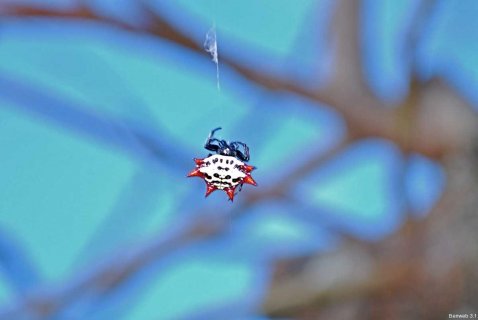
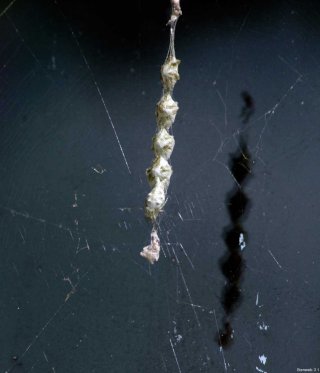
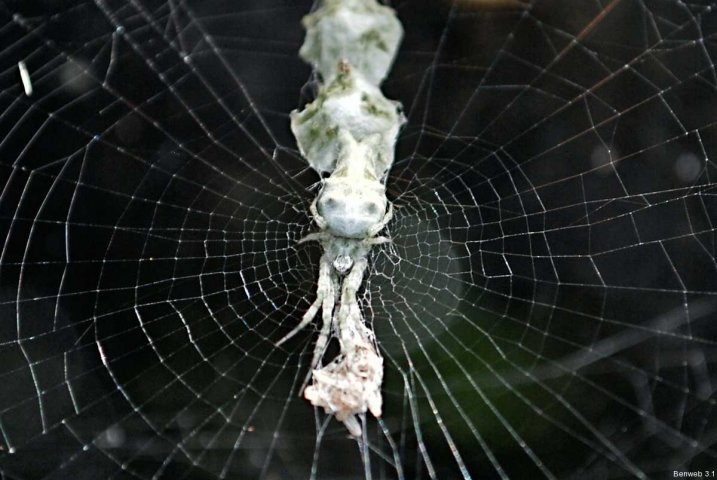
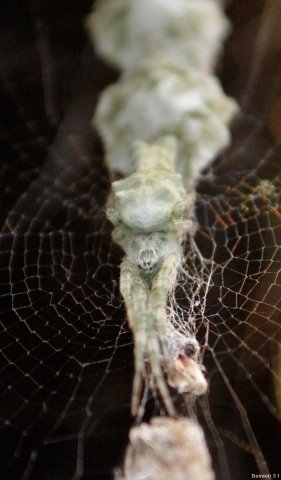
Ben, the posted photos of A. bifurca are excellent. Did you take them?
If so, may I borrow an image for an in-house training piece? And if yes,
what is your last name so I can credit you properly as the photographer?
Hello, I was so pleased to read your article regarding the Allocylosa bifurca. This amazing little spider has lived on my porch window for the last two months. I am a photographer and Macro is my specialty. The spider is very unique and I had no idea what it was. I Googled the description and was lead to your website. The fun part is, I live in Merritt Island, FL where the first one was discovered! I thought that was pretty neat to have this spider living with me and now knowing that they were discovered in my home town. Thank you for the amazing article. I am happy to be educated on my model spider. I will post macro images of the Allocylosa bifurca living on my porch to my website. If you are interested, you can check it out at http://www.perronephotography.com Click on Galleries and find the Macro album. I hope you like the images! Thanks again for the information!!
Kind Regards,
Amy Boone
Thanks for the kind words, Amy.
Glad to supply some info for you.
I’ll look for the photos on your gallery page; I don’t see them there yet, but the rest of your work is certainly worth browsing through while I wait!
I’ll check back later.
–Ben
thanks for the info. I’ve got a few of these in my tomato garden. thought it was the big black and yellow garden spider but you have identified it perfectly. We get the big garden spiders in the late summer and early fall and they build the same kind of contraption as this spider.
We have numerous orbs all over our lanai in Boynton Beach Fl.
We try to get rid of them each month and the keep coming back. Is the spider poisonous and how can we get rid of Them?
The only way I know of to get rid of spiders is manual. Keep removing their webs AND remove what they’re eating. If there’s no insect prey for them, the population won’t last. But getting rid of insects in a lanai would probably cause more damage to your own health than permanent “success.” I’d recommend removing the webs that are within easy reach and letting those higher up continue to perform pest control duties for you.
And yes, all spiders are venomous. These spiders aren’t aggressive, and their bite isn’t dangerous, although you can still get a nice red bump and some irritation for a couple of days. Allergic reactions, though rare, are also possible, I’ve been told.
Spiders are probably also poisonous, but you’d have to eat a lot of them for them to make you sick.
This is my first year with Allocyclosa bifurca on my porch for control of small flies. They just moved in. Thanks to your article I was able to relocate several individuals safely before spray cleaning the screen. Thank you for the warning about the bites! I was surprised to find many of the webs in disrepair and clearly abandoned. While efficient, this spider does leave an unsightly mess. Next year I’ll be encouraging the pretty little green spiders with the orange spots instead. Their webs don’t get so ugly and they tend to be a bit higher up. Does that seem like a good idea?
There are hundreds of these spiders in their webs on the inside of the pool screen , hanging down from the top which is high over the pool and on the sides of the screen. This may explain having to remove so much bug debris from the water before we can swim.
So they’re sort of performing a service (bug cleanup) and disservice (bug debris) for you at the same time!
Ben, thank you for your pix and info on this spider. They are infesting my outdoor patio hanging from the ceiling. Now, thanks yo you, I know what they are. Question is, now after reading all your comments, are they eating enough insects to put up with them ( not likely in my opinion) or how do I get rid of them for good?
I was looking up what was kind of spider was creating these “chains” of eggs here in Central FL.
Thanks so much for the article. What a neat adaptation!
I live in Westchester County New York and just found a big messy web by my front door with egg clusters hanging in a line as described here. Can they live this far North? I will be watching but not disturbing them!
I don’t know how far north they might range. I somehow doubt that they’d be up there, but it wouldn’t surprise me if I’m wrong!
I’m in Tampa Bay and had a pool built last year. These spiders, and brown widows have infested my screened in pool area to the point my family doesn’t want to be outside using our $80,000 investment in relaxation. We.have hometeam pest defense and it’s made no difference. I cleaned a bunch of webs up yesterday only to find them back again this morning. Help!!
Oh no, Dan, that’s devastating! I found a bunch of those vertical egg sacs around our screened-in balcony this morning as I was putting away our Christmas decorations in our back closet. I took a broom and went around the balcony ceiling trying to remove them. I think I managed to get most of them and then got a large trash bag and put the broom brush inside. Maybe they’ll suffocate to death? For me, they’re just a nuisance. I have photos too!
I believe my husband was bitten on our lanai on his forehead multiple times and he is very sensitive to them swollen glands and hot to touch and getting crusty. Is this possible? Hope it resolves quickly.